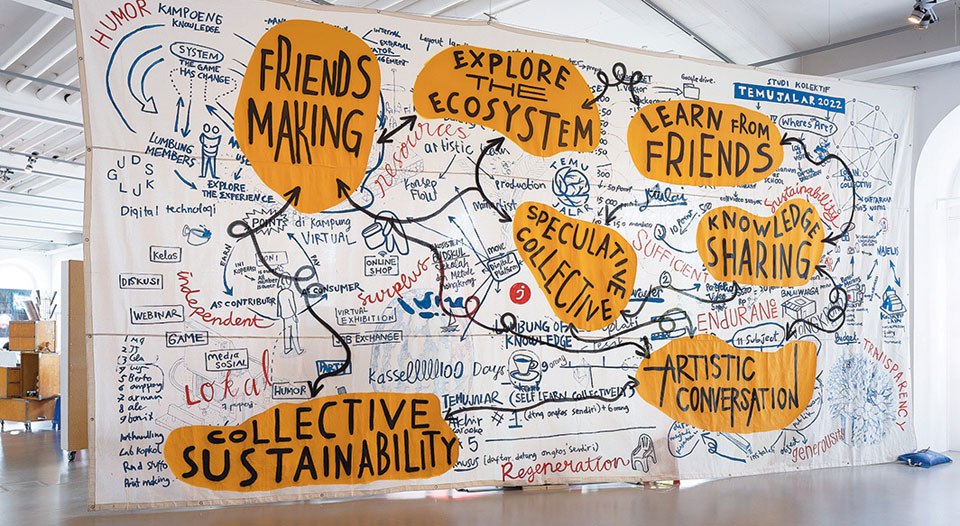
KASSEL, Germany — This two-part article will consider the impact of a monumental event in the art world, the turning over of the every-five-year art festival Documenta, in Kassel, to a series of collectives under the organizational framework of the Indonesian group Ruangrupa, the first such direction of a major art festival in the West by a developing world group, and Asian and Muslim at that.
Ruangrupa and the 50 participants, mostly collectives, proceeded to rethink and refashion, in an activist mode, the foundational concepts of not only how the art object is presented, but also the place of art in the developing world and in the West, and finally how art is, rather than simply being “consumed,” capable of critiquing the productivist development of the West and of posing new ways of being and new solutions.
For daring this wholescale reimagining, the project has been roundly criticized, most often under the rubric of anti-Semitism, anti-Zionism and criticism of the policies of the Israeli state. This first article will lay out the critique Documenta poses, and the second will consider the attack on it as well as examining a more art world-friendly, but still cantankerous and challenging simultaneous presentation a few hours away in Berlin, the Berlin Biennale. Documenta closes this weekend, the Biennale closed last weekend; but both have challenged and in ways tried to upend preconceived perceptions both in the art world and in the world at large.
Let’s start with the radical slogan of this year’s art festival in Kassel: “We are not in Documenta fifteen, we are in lumbung one.” In Indonesia a lumbung is a rice barn where the surplus harvest is stored to benefit the community in time of need. Ruangrupa defines lumbung as extended to this festival and, more importantly, to the greater world, as a practice of collectivizing the fruits of the system of production for the benefit of all. The concept is a developing world answer to the private and extractive schemes of the West which have menaced and exploited the rest of the planet for so long.

In the art world, the application of lumbung means not only throwing the festival open to collective labor but also viewing art not primarily as commodity and as part of a commodity exchange, but rather, making primary the practice of art as a means of opening up group participation and education. Thus, art is not individually consumed but rather collectively digested as an opening to changing the world. As such this definition also challenges, as Ruangrupa says, “the old system…[of] state funding and/or free market art systems or even biennial circuits [such as Documenta]” which it defines as “highly competitive, globally expansive, greedy and capitalist—in short exploitative and extractive.”
Thus, for example, another Indonesian collective, Taring Padi, uses cardboard cutouts in street demonstrations and murals to indict the killing underlying the global foundation of Indonesia’s island paradise Bali, financed by Western capital and built on the graves of the dead.
These art works then resist being torn from their function in their real-life social-political context and point the way to an art that is “no longer pursuing mere individual expression, no longer needing to be exhibited in stand-alone objects or sold to individual collectors and hegemonic state-funded museums.”
“Lumbung calling,” another slogan of the festival, this one adopted from The Clash’s apocalyptic fable “London Calling,” is here converted into a plea for humanity to avert the apocalypse. In practice this has meant work that, unlike many of the objects in the Berlin Biennale, does not obscure the issue by hiding behind the patina of making vague statements through a highly conceptual veil of abstraction. For daring to confront these issues directly, for bloodying itself with a confrontation of the actual results of these centuries of Western colonialism, the first critique that this version of Documenta faced by Western critics was that this was “not art.”
The difference was striking between the Biennale, with its more traditional mode of spectators passively contemplating individual works and measuring their comprehension against the artist’s concealed intent, and Documenta, with its groups of students and mostly young people engaging with and working out, through various spaces provided by the festival, the ways in which the works spurred discussion and involved participants, attempting to turn them from commodified consumers into activists together groping for means of change.

As in the metaphor of lumbung, the rice collective, many of these means recalled earlier methods of being part of the earth, as in the elaborate Vietnamese garden constructed on the grounds of a well-known local nightclub by a Hanoi collective. But also, and necessarily, their works bore the traces of formerly or still colonized peoples laboring under the burden of “developing nations,” a sobriquet that conceals the fact not only that they have been vastly underdeveloped and exploited by the West but also that their path should be itself productivist, always “developing.” Thus, at the Fridericianum, the main site of the festival, there was a tent labelled “Indigenous Embassy.” Its slogan was “We want land not handouts,” as everywhere on earth the claims of the original tenders of the earth are gathering steam and being taken more seriously as their practices vie for attention against harmfully extractive methods which are destroying the planet. To cite two, the battle in Canada for its place as leading mineral miner versus the claims of those on the land whose life will be upended; and Biden’s “Environmental Protection Bill” which opens Alaska and the Gulf of Mexico up to oil drilling. At the festival, a Times Square-like continual ticker above the building kept pacing out the money the Australian government owes First Nations groups from 1901 to the present, with the figure reaching into the trillions and still counting.
Out into the ekosistem
Instead of simply locating themselves in the two main halls, as other iterations of the festival have done, Documenta’s collectives have also expanded out into the city, in what Ruangrupa calls “the ekosistem.” The institution itself, begun in 1955, was designed as an antidote and mea culpa for the role the very site of Kassel played as a primary manufacturer of the armaments which fueled the Nazi war machine. As such, Documenta, the most political of all art festivals, has always taken as its mission to highlight this grievous moment in the city’s past.
This trend broadens in this latest iteration as the lumbung Documenta expands or “occupies” not only various sites in the city but also expands its critique to encompass the postwar development of what became known as “the city of the car.” The automobile replaced weapons manufacturing in the 1950s “economic miracle,” a situation globally that has accounted for numerous deaths in densely populated urban areas because of diesel pollution.
Thus, the headquarters of the clothing company C&A, an unadorned and monotonous façade typical of postwar reconstruction, is illuminated with a Taring Padi banner ablaze with color and featuring a steadfast Karl Marx in the upper corner. He’s looking askance at the company which profited under the Nazi regime, seizing Jewish assets and employing forced labor, and which has also been accused equally in the global neoliberal era of employing sweatshop labor from the developing world.
A square—a Platz—near the town center is covered underfoot with headlines from Romanian Dan Perjovschi’s Horizontal Newspaper, with one containing the slogan WAteR, proclaiming the water wars to come, another ominously announcing that “I am so grateful to be in the last documenta,” and a third picturing a word balloon from an ocean liner whose cheery passengers address those below being submerged in a raft with the comforting slogan “We are all in this together.” Perjovschi’s project, as does much of the work here, democratizes the staid art-world convention of Conceptualism, where meanings are obscure and which led not to a critique of art-world materiality but only to a new form of commodification, this time focusing on the word as salable object.

What might have been a plaza, a public place for gathering at the corner of two streets in the center of Kassel, because of the dominance of the automobile in ’50s city planning—which with its concentration on freeways devastated whole communities in, for example, Boyle Heights in Los Angeles and in Houston—became simply a traffic circle with pedestrians directed underground. Ruangrupa turned the bleak underground space over to the Black Quantum Futurism collective from Philadelphia, whose lively photo montages with slogans over a slave ship read, “Black People Navigate Western Timelines as Our Ancestors Did the Stars” and “Dissolve the Arrow of Progress,” as the Black Futurist Collective called attention to the global devastation this “progress” caused.
It must be mentioned also that with the Ukraine war now being the prompt for Germany and Japan to rearm, Kassel is again becoming a site of not only the manufacture of cars but also of weapons building for a new German War Machine. What could possibly go wrong?

The extension out into the city also featured multiple works in the manufacturing district of Bettenhausen, generally ignored in previous Documentas. The Hallenbad Ost, formerly a workers’ swimming facility, was taken over by Taring Padi, the most radical group in the festival. That Taring Padi should install itself in a workers’ facility is fitting since the group, from Yogyakarta, aligns itself with working-class concerns. The collective traces its origins to its involvement in protests and street demonstrations at the moment when the 1997-98 Asian Financial Crisis brought down the longtime U.S.-supported dictator Suharto. The name itself means “fangs of rice,” suggesting the grain can support a community but also that it can bite opponents. The lawn of the Hallenbad Ost, part of an interior and exterior display of over 100 objects from the group’s 22 years of active protest, was filled with cardboard cutout puppets used in street demonstrations, called wayang kardus, which take the more elite form of Indonesian puppet theater and make it available for expressing people’s political concerns. One cutout had a Suharto figure clutching money bags while hovering over a ballot box and swaying
elections.
A gorgeous multitude of murals often visually cites the Mexican muralist David Alfaro Siqueiros. One has a woman in the center, as a figure linking Indonesian and Mexican Indigenous peoples bursts her chains. Another mural transposed Hieronymus Bosch’s vision of hell into a modern history of the diabolical world of Indonesia’s exploitation by successively the Dutch, the Japanese, and Suharto and the global finance backing him.
That moment was laid out in a series of murals about the murder of thousands on the island of Bali in 1965-66, and the subsequent decision, even as the killings of the island’s left and any who had an association with them continued, to build Bali into a global “pleasure dome” with money supplied by “the World Bank, The French Tourism Board and the UN Development Program.” The construction was done, Taring Padi relates, with no input from those on the island and with hotels possibly built over the mass graves which concealed this largest massacre in the country’s history, worse than the Dutch or the Japanese. One black and white mural accompanying this story features an army officer prominently leading and salivating over the killing below him.

Countering this is a stunning full-color mural of an Indonesian princess with a tiger striding majestically across a busy modern intersection. In the background are billboards proposing “Skin Care” and other Western capitalist beauty products which the commanding natural beauty of the princess negates. Her almost mystical presence also recalls Indonesian folklore and its use in sustaining the country against its history of incursions outlined, for example, in Eka Kurniawan’s novel Beauty is a Wound.
Finally, a more traditional art-world presentation was to be found in Kassel’s Sepulchral Museum, containing medieval burial objects, in an exhibition about myth by Mexican artist Erick Beltrán. A wall of various mythical representations is introduced by standard late post-modern art-world gobbledygook claiming that myths only produce “vacant meaning” and are “unknowable and equal” (so thus why try to understand them?). The one saving grace of a juxtaposition of images which never exceed their place as pretentious collage is that of Facebook (now Meta) founder Mark Zuckerberg with a slightly oversized nose as Pinocchio, calling attention to the lies he tells at every congressional hearing to outwit those who would regulate his enterprise.
Documenta 15—the lumbung Documenta—opens the way for a developing world conception of art that directly embraces the current world crisis and that challenges and will continue to challenge Western traditions and institutions. The attack by those institutions is the subject of the second part of this series.










